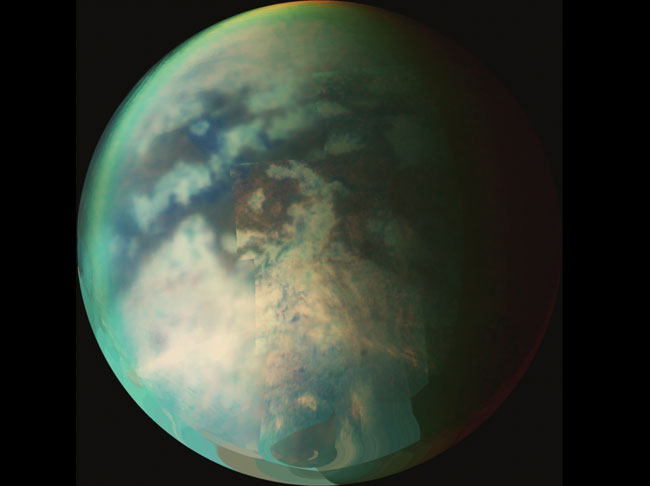Earth's Future Glimpsed on Titan

The enigmatic Saturnian moon Titan is still yielding surprising new details years after scientists first pierced its thick haze veil. The vision now emerging of Saturn's largest moon, with its giant dunes and oceanless surface, is perhaps a glimpse of Earth's desert future.
"Titan may be very different from Earth today, but maybe not Earth tomorrow," Jonathan Lunine, Cassini-Huygens interdisciplinary scientist at the University of Arizona, told SPACE.com.
The surface of Titan was a total mystery before the Huygens probe infiltrated past its dense hazy atmosphere in 2005. After a seven-year voyage aboard the Cassini spacecraft, Huygens spent roughly two-and-a-half hours parachuting down and then sent transmissions from Titan's surface for another 70 minutes before Cassini moved out of range. The mission was a joint project of NASA, the European Space Agency and the Italian Space Agency.
"Even though we have only four hours of data, it is so rich that after two years of work we have yet to retrieve all the information it contains," says François Raulin, Huygens interdisciplinary scientist at the Laboratory of Environmental Physics and Chemistry in Paris.
Lunine explained that "a number of instruments aboard Huygens simply require quite a lot of calibration and cross-checking to get a sensible result."
Episodic rain
Stereoscopic images from Huygens now reveal extremely rugged terrain in the bright highlands north of the probe's landing site. This includes channels divided by ridges that can rise some 500 to 650 feet high, with slopes of 30 degrees. Their shapes suggest they are drainage channels, cut by liquid methane falling as rain, findings detailed in a special issue of Planetary and Space Science magazine.
Breaking space news, the latest updates on rocket launches, skywatching events and more!
"Rains on deserts on Earth can take be spaced by months to years, but on Titan we're talking about hundreds, maybe thousands, of years between episodes of major rainfall that comes down perhaps violently," Lunine said. "Because Titan is so much farther from the sun than
Earth is, it takes longer for solar energy to evaporate methane and build it up in the atmosphere enough to generate storms."
The fact that methane apparently moves from the atmosphere to the surface and back again on Titan just as water does on Earth makes Titan "in some ways the best analog for an Earth-like planet we have," Lunine said, as compared to Mars, which has too tenuous an atmosphere, or Venus, which has just the opposite. "Essentially all the processes we see in Titan are in some sense connected with methane, just as processes on Earth are in some sense involved with water."
Desert world
Before Huygens penetrated Titan's haze, scientists suspected oceans of liquid methane and ethane covered its surface, evaporation from which could explain the smog-like compounds in its atmosphere.
Instead, they found giant dunes likely composed of sugar-sized hydrocarbon grains girdling its equator, each stretching up to 60 miles long across dark plains that bear markings suggesting occasional flash flooding.
Any surface lakes and seas might be confined to Titan's polar regions.
"There's a sense here of a desert world. Not in terms of being hot—Titan is very cold—but in terms of being very dry," Lunine said. "Titan lacks oceans, but someday Earth will, too, as the sun increases in brightness, boiling the oceans away and leaving Earth a desert planet."
Hidden liquid
Mysteries remain as to where the liquid that carved Titan's valleys, channels and gullies is hiding. Enigmatic radio waves Huygens detected could help reveal this liquid is hiding in the deep interior of Titan, perhaps released by geysers or vulcanism.
The probe's Permittivity, Waves and Altimetry (PWA) sensor detected an extremely low frequency (ELF) radio wave during Huygens' descent. If this signal is natural and not accidentally generated by the instrument, studying how ELF waves resonate on Titan could shed light on any oceans that may exist below Titan's surface and how deep they are. Researchers have already ruled out electrical interference from the instrument itself.
As to what may have generated this ELF wave in the first place, no one is quite sure yet.
"It might be generated by an interaction with Saturn's magnetosphere or related to Titan's intrinsic fields," suggested Fernando Simões, a member of the PWA team. "Titan is proving to be an intriguing environment."

Charles Q. Choi is a contributing writer for Space.com and Live Science. He covers all things human origins and astronomy as well as physics, animals and general science topics. Charles has a Master of Arts degree from the University of Missouri-Columbia, School of Journalism and a Bachelor of Arts degree from the University of South Florida. Charles has visited every continent on Earth, drinking rancid yak butter tea in Lhasa, snorkeling with sea lions in the Galapagos and even climbing an iceberg in Antarctica. Visit him at http://www.sciwriter.us
